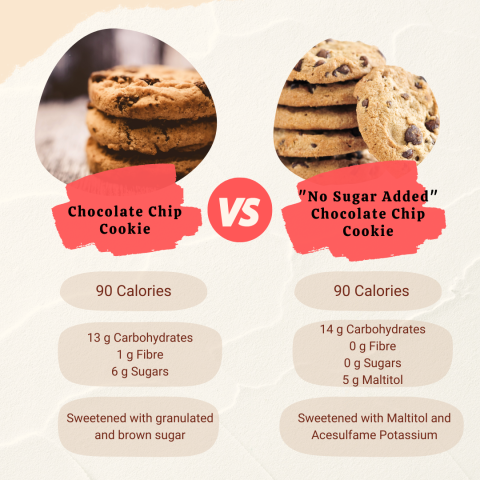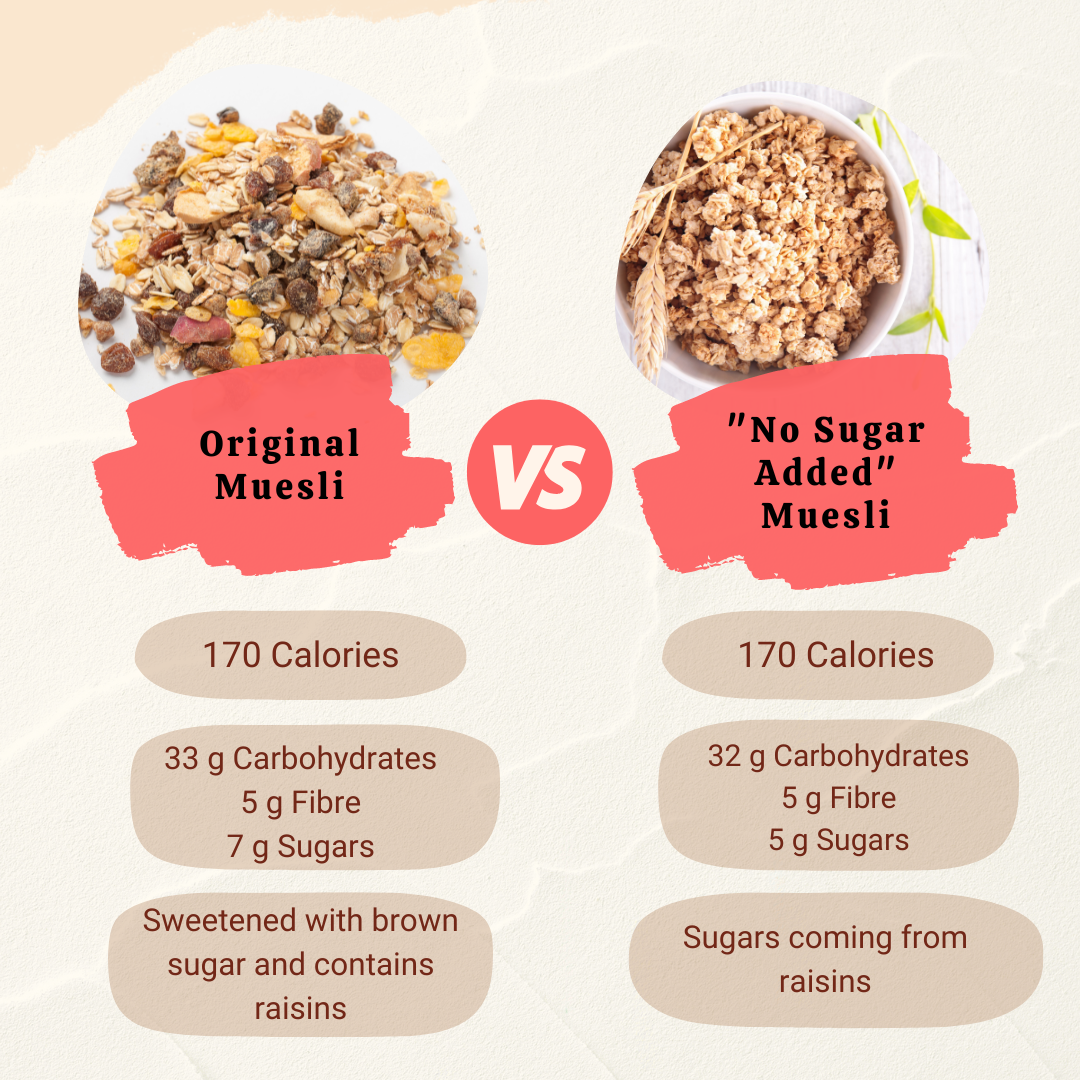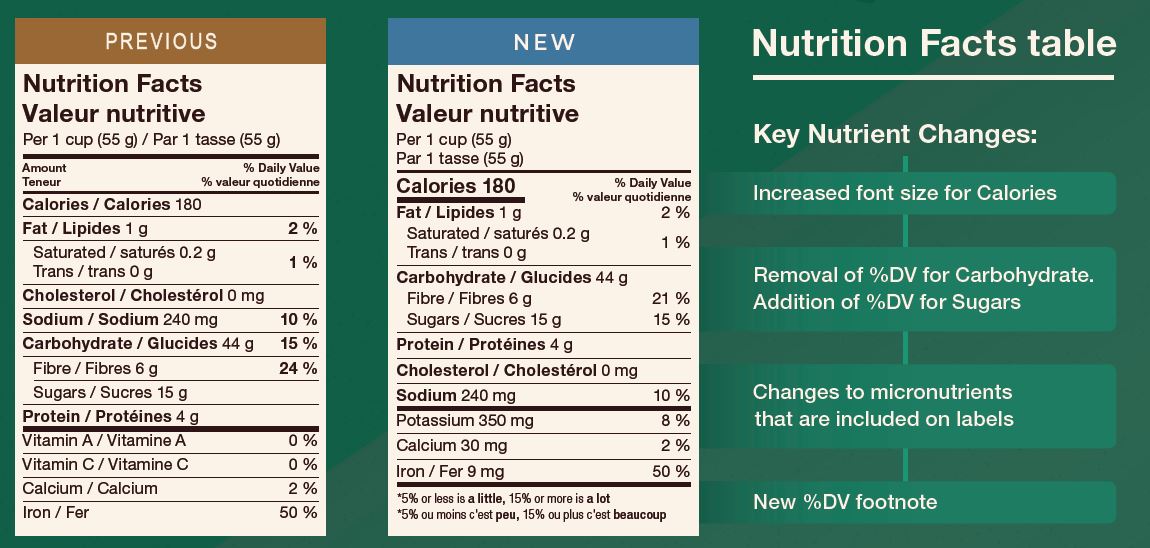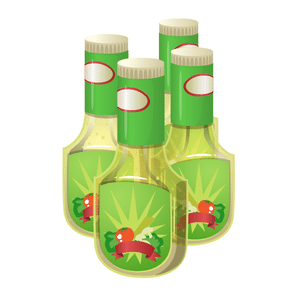Health Canada has made several changes to the Nutrition Facts table and List of Ingredients, which you may start seeing on packaged food labels now, and should be fully implemented by December 2023 (1). These changes provide additional information on sugars to help Canadians compare sugars content of products more easily and make informed choices for healthy eating:
- The Nutrition Facts table. This lists the amount of total carbohydrate, including total sugars in a stated serving size. A % Daily Value for total sugars has been added to the Nutrition Facts table.
- The List of Ingredients. The ingredients list identifies all types of sugars and sweetening ingredients in the food or beverage in descending order of quantity. All sugars-based ingredients are now grouped together in brackets in the List of Ingredients.
- Sugars-related Nutrient Content Claims. There are six nutrient content claims related to sugars permitted in Canada, including one new claim.
Carbohydrates and Sugars in the Nutrition Facts table
The Nutrition Facts Table lists the amount of total carbohydrate, including total sugars, starches, and fibre in a stated serving size (2, 3).
- “Sugars” refers to total sugars, and includes both naturally occurring sugars in fruits, vegetables, and milk products, as well as sugars that are added to foods (e.g. sugar, brown sugar, glucose-fructose, honey, maple syrup, concentrated fruit juice).
- Whether a mono- or disaccharide is naturally-occurring or added to foods, the chemical composition is identical and is broken down the same way. For example, sugar (sucrose) from sugar cane or sugar beet has the same chemical make-up as the sucrose found in all fruits and vegetables and is used as a source of energy by the body in the same way.
Among the changes to the Nutrition Facts table,
- The % Daily Value (DV) for Carbohydrate has been removed;
- A DV for Sugars has been introduced at 100 g of total sugars, which is equivalent to 20% of a 2,000-calorie diet and is close to the average level of consumption of total sugars in Canada;
- According to Health Canada, “this value is not a recommended level of intake. Instead it is the amount of total sugars that is consistent with a healthy eating pattern”.
- The DV for fibre increased from 25 g to 28 g (1).
The % Daily Value for total sugars has been included to help consumers:
- Compare the sugars content per serving of different foods, and
- Understand the relative amount of sugars in the context of total daily consumption.
For more on what 100 g of total sugars can look like as part of a day’s worth of eating, view our resource “The Sweet Spot Challenge: A Compilation of Daily Menus Based on the 100 gram Daily Value for Sugars”.
Sugars in the Ingredient List
All pre-packaged foods require a List of Ingredients (2, 3). Ingredients are listed in descending order by weight, therefore the ingredient that weighs the most is listed first and the lowest weight ingredient listed last.
To make it easier for consumers to identify all the sources of sugars added to a food or beverage, the new labelling regulations require that all added sugars ingredients be grouped together in brackets following the term “Sugars” (1). Functional substitutes that act as sweetening agents such as fruit juice concentrate and maltodextrin are also grouped under "Sugars". The placement of Sugars within the ingredient list will depend on the total weight of all the sugars ingredients combined.
DID YOU KNOW?Unlike in the Nutrition Facts table, the term “Sugars” in the ingredient list includes only sugars-based ingredients (all added sugars and functional substitutes such as fruit juice concentrate and maltodextrin), but not sugars naturally occurring in fruits, vegetables, and dairy sources. |
Some of the common types of sugars you may find in the ingredient listing include:
| Sources | Sugar cane/beet sources | Corn sources | Other sources |
|---|---|---|---|
| Types |
Sugar Brown sugar, golden sugar Icing sugar Invert sugar Golden syrup Turbinado sugar, demerara sugar Molasses, fancy molasses |
Glucose/fructose (high fructose corn syrup) Corn syrup Corn syrup solids Dextrose Glucose High maltose corn syrup |
Agave syrup Coconut sugar Date sugar Fruit juice concentrate Honey Maple syrup Rice syrup Maltodextrin (without fibre) |
*Sugars ingredients do not include high-intensity sweeteners, sugar alcohols, or dextrins.
Below are a few examples of how the grouping of sugars may give consumers better information about the sugars-based ingredients, by weight, in different food products.
| Food Product Example and Ingredient List | Comments |
|---|---|
|
Bran cereal with raisins Ingredients: Whole grain wheat • Raisins • Sugars (Sugar, malted corn and barley syrup) • Salt • Sunflower oil • Calcium • IronHuile |
|
|
Ingredients: Water • Sugars (concentrated white grape juice, strawberry puree, concentrated raspberry juice, concentrated blackberry juice) • White wine vinegar • Canola oil • Dijon mustard (water, mustard seeds, vinegar, salt, turmeric) • Salt • Concentrated lemon juice • Poppy seeds • Spices • Xanthan gum |
|
|
Seasoning mix |
|
Sugars-Related Nutrient Content Claims
Nutrient content claims are statements that highlight or describe the amount of a nutrient in a food (2, 3). There are six nutrient content claims related to sugars permitted in Canada, including one new claim:
| Sugars – Related Claims | Regulations |
|---|---|
| "sugar-free", "free of sugar" "no sugar", "0 sugar", "zero sugar", "without sugar", "contains no sugar", "sugarless", "0 sugar", "zero g sugar","0 gram sugar", zero gram sugar" |
|
|
*NEW* "low in sugars", "low in sugar", "low sugar", "low source of sugar", "little sugar", "contains only (number) g of sugar per serving", "contains less than (number) g of sugar per serving" |
|
| "reduced in sugar", "reduced sugar", "sugar-reduced", "less sugar", "lower sugar", "lower in sugar" |
|
| "lower in sugar", "less sugar", "lower sugar" |
|
| "no added sugar", "no sugar added", "without added sugar" |
|
| "unsweetened" |
|
*Note: Only the terms and wording outlined above from the Food and Drug Regulations can be used to make a claim.
** “Similar reference food” means a food of the same type as the food to which is it compared and that has not been processed, formulated, reformulated, or otherwise modified in a manner that increases or decreases either the energy value, or the amount of a nutrient that is the subject of the comparison.
Note: For foods that display a “high in sugars” front-of-package symbol,
- “Free of sugars”, “Low in sugars”, “Lower in sugars”, “No added sugars”, and “Unsweetened” claims are prohibited to avoid consumer confusion.
- The claim “Reduced in sugars” is permitted to allow companies to highlight reformulation efforts.
Are "reduced in sugar" or "no sugar added" products a better choice?
Because sugar plays a variety of roles in food products - from sweetness to adding bulk, colour, mouthfeel, and texture - other ingredients, such as starch and fat, are often used to replace these functions (4,5). According to a recent publication by researchers from the University of Toronto, "products reformulated to be lower in sugar are not consistently lower in energies, due to an increase in starch". In addition, the reformulated product may have a longer list of ingredients, may need additional warning statements on the label (e.g. aspartame), and may cost more.
For example:

Comparing a regular pre-packaged chocolate chip cookie to a “no sugar added” version:
• Calories per cookie are exactly the same.
• Carbohydrates are actually higher in the “no sugar added” cookie.
• Sugar was replaced with maltitol, a sugar alcohol, and acesulfame potassium, a non-caloric artificial sweetener.

Comparing a regular muesli cereal to the company’s “no sugar added” version:
• Calories per ½ cup serving are exactly the same.
• Carbohydrates and fibre content are similar between the two versions.
• Sugars was reduced by two grams in the “No Sugar Added” version. The remaining 5 g sugars in the reformulated version are coming from raisins.
The ingredient list and Nutrition Facts table for these and other reformulated products, will identify any changes in composition and nutritional value. This allows consumers to compare these products for carbohydrate and calorie information.
For more information on sugars labelling, additional resources include:
- Infographic - Learning about Sugars Labelling: New Nutrition Information
- The Sweet Spot Challenge: A Compilation of Daily Menus Based on the 100 gram Daily Value for Sugars
- Video “Is Sugar Hidden in Foods?” featuring dietitian Christy Brissette
- Health Canada – Table of Permitted Nutrient Content Statements and Claims
- Health Canada – Criteria for the Nutrient Content Claim No Added Sugars
- Health Canada – List of Permitted Sweeteners
- Health Canada Nutrition Labelling Online Course
Recent news items include:
- August 2022 - Reading Food Labels: New Changes to Sugars-Related Claims
- May 2022 - Reading Food Labels: New Information on Sugars
- March 2017 - Recent Research on Front-of-Package Labels
References
- Food Labelling Changes, Health Canada
- Food and Drug Regulations, Department of Justice Canada
- Guide to Food Labelling and Advertising, Canadian Food Inspection Agency
- Bernstein, J., Christoforou, A., Weippert, M., & L’Abbé, M. (2020). Reformulation of sugar contents in Canadian prepackaged foods and beverages between 2013 and 2017 and resultant changes in nutritional composition of products with sugar reductions. Public Health Nutrition, 23(16), 2870-2878.
- Vergeer L et al. The relationship between voluntary product (re)formulation commitments and changes in the nutritional quality of products offered by the top packaged food and beverage companies in Canada from 2013 to 2017. BMC Public Health, 2022;22(271).




.png)
 Fruit-berry salad dressing
Fruit-berry salad dressing 